Learn the Faux Pedal Steel Technique
Here's how to emulate the weeping sounds of this signature country-music instrument on a guitar

I’d like to demonstrate some ways in which you can emulate the sweet sounds of country-style pedal-steel note bends, which often occur with two- and three-note chords. This endeavor is another animal altogether, one that seems to demand a bare-fingers approach coupled with sheer strength.
I discovered this technique when I had to learn how to approximate the great Red Rhodes’ pedal-steel licks from the Fraternity of Man’s 1968 hippie anthem, “Don’t Bogart Me,” for 2018’s An Unpredictable Evening with Todd Rundgren tour.
In this lesson, I’ll present examples inspired by this song.
A word of caution: Some of these bends may hurt a bit at first, so don’t overdo it! Those who are weak of finger are advised to try using lighter gauge strings.
Patience and persistence will pay off and gradually yield surprisingly sweet and satisfying results.
What Goes up Must Come Down (or Not)
A major part of the pedal-steel sound entails precisely bending into (and out of) chord tones, so we’ll begin by examining three different kinds of bends.

Ex. 1a features a double-stop bend in which the second and third strings are raised a half step and a whole step, respectively.
We’re in the key of E, bending the root and 3rd (E and G#) up to the 2 and 4 (F# and A, respectively), and then releasing the two-string bend back to its point of origin.
This creates a momentary Esus4/2 suspension that resolves back to E when the bends are released.
Ex. 1b makes the same move even more steely by delaying the onset of the double bend by an eighth note, in this case the second note of an eighth-note triplet.
This important double-stop bending technique – which we’ll be seeing a lot more of – allows you to briefly hear the E dyad (E and G# ) before the bend up to Esus4/2, which may also be thought of as F#m over E.
Ex. 1c illustrates an oblique bend (where two notes are played, but only one is bent) with a 5-to-6 bend (B-to-C# ) played below a stationary E root – a move that could also be construed as an oblique bend into a partial A chord – before being released to B, creating the sound of an E6 chord moving to E.
Ex. 1d applies the same rhythmic variant from Ex. 1b for extra steeliness.
In all four previous examples, we’ve been bending away from the tonic E chord before releasing back to it.
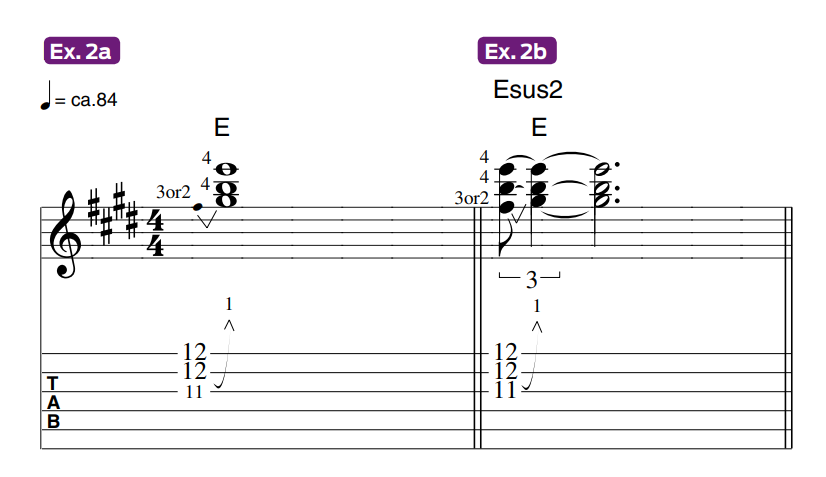
In Examples 2a and 2b’s oblique bends, we’re bending into the E chord, first using an F#-to-G# grace-note bend to form an E triad, and again with the delayed eighth-note triplet feel creating a momentary suspension.
Both bends are played below a stationary root over 5 (E over B).
Set-up and Application
Before we get steely with a phrase inspired by the “Don’t Bogart Me” intro, let’s explore the lay of the land by mapping it out first, without bends.

Ex. 3a shows the three-beat E-F# m-G#m pickup, which utilizes a I-ii-iii diatonic-triads approach to the IV chord, A, in bar 2 (actually bar 1 of the four-bar intro).
Here, a grace-note hammered double-stop and ensuing triplet eighths on the B and G strings form an Asus4/2-A suspension and resolution, which are subsequently transposed up a whole step to cover the similar Bsus4/2-B V-chord moves in bar 3.
Bar 4 resolves to two beats of a 12th-position E triad, followed by the IV and V chords on beats three and four, before breaking on E on the downbeat of bar 4.
Ex. 3b transforms the same pickup and four-bar intro figure into a faux-pedal-steel fest.
The E-F# m-G#m pickup is played as three staccato accents, each preceded by its lowest note – the 5 of each chord – on the first three shuffled eighth-note upbeats.
This leads into a double-stop bend on the downbeat of bar 2 – the same one from Ex. 1a, albeit transposed up a fourth to cover A, the IV chord – followed by the same A-Asus4/2 bend played during the last two triplet eighths in beat two before releasing back to A on beat three.
In bar 3, the same opening bend is shifted up a whole step and two frets and rephrased with a bend-release-bend move, generated from a single pick attack and played on the first two notes of a quarter-note triplet.
A two-note pickup leads into a position shift to E, using the oblique bend from Ex. 2a, which is held for the first triplet eighth of beat two and then released, via a picked grace note and subsequent pull-off to E during the remaining two triplet eighths.
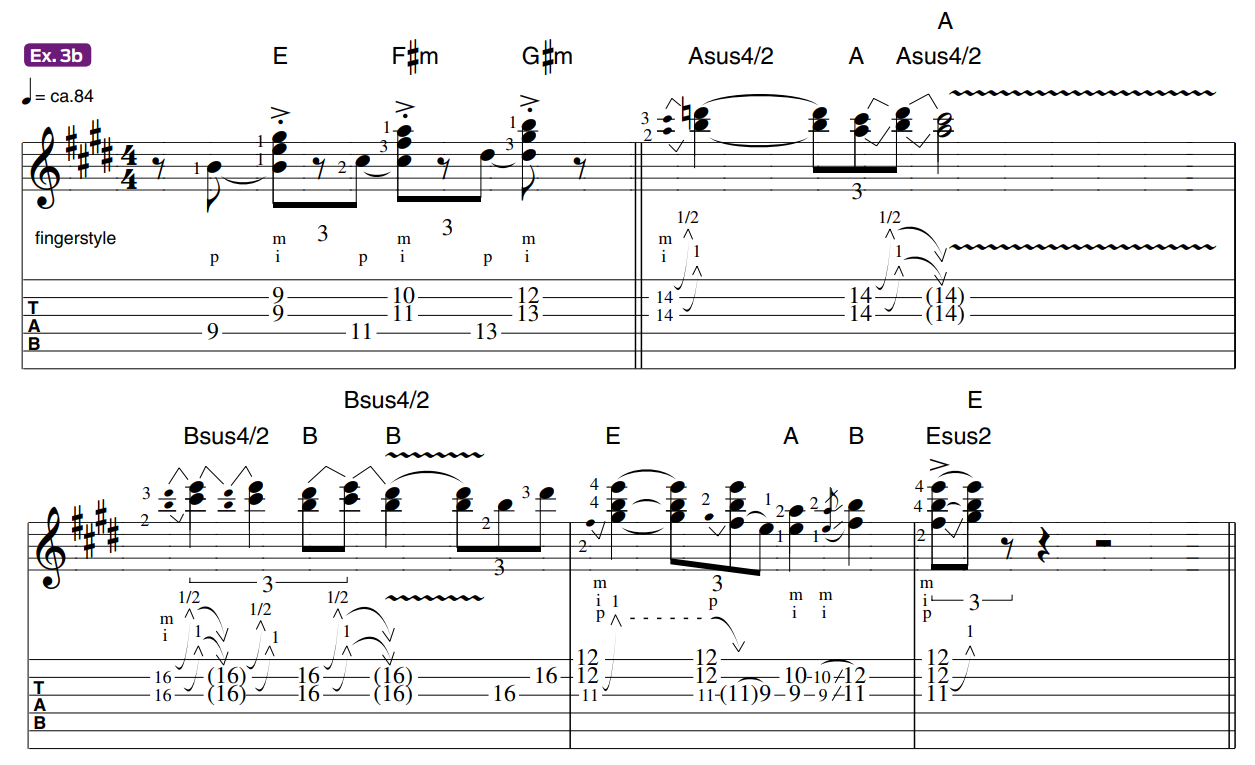
We’ll be seeing more of this move in later examples.
A pair of parallel fourths outline A and B on beats three and four (note the grace-note finger slide on the latter) before we conclude with a cut-off version of the oblique-bend variant from Ex. 2b.
Be sure to use the left- and right-hand fingerings indicated.
Alternative Facts
The pickup and four-bar figure shown in Ex. 4 can serve as an alternative intro, or as the second half of an eight-bar chorus.
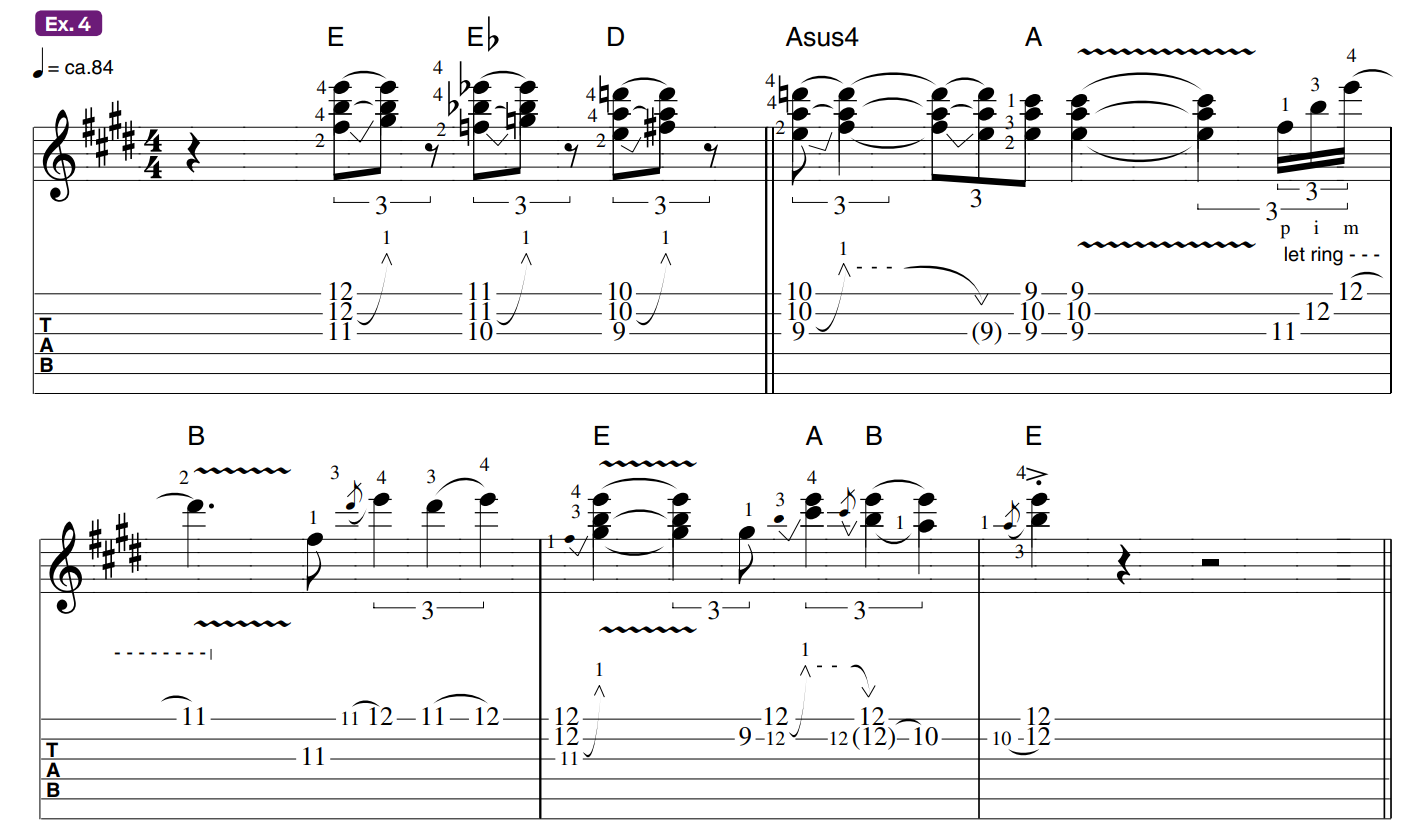
The pickup bar commences on beat two with the obliquely bent E triad from Ex. 2b, followed by the same move played in descending half steps, from Eb to D, on the remaining two beats. (Tip: Use the same style of fingerpicking notated in Ex. 3b.)
The bent D triad on beat four is reprised, held and released as Asus4-D-Asus4 when we cross into bar 2, until it resolves to A at the tail end of beat two and for most of the next two beats.
The pickup into bar 3 features a fingerpicked banjo-style roll that arpeggiates a Bsus4 chord before we pull off the top note a half step, to imply a resolution to B on the downbeat, and add a quarter-note triplet of variously hammered single-note suspensions to complete the measure.
Ex. 2a’s bent E triad makes another appearance on the downbeat of bar 4, followed by the oblique bend from Ex. 1c.
This is sustained once again, until its picked grace-note release and subsequent pull-off in the middle of the quarter-note triplet that encompasses beats three and four.
It then concludes with an oblique double-stop hammer-on that nails the I chord.
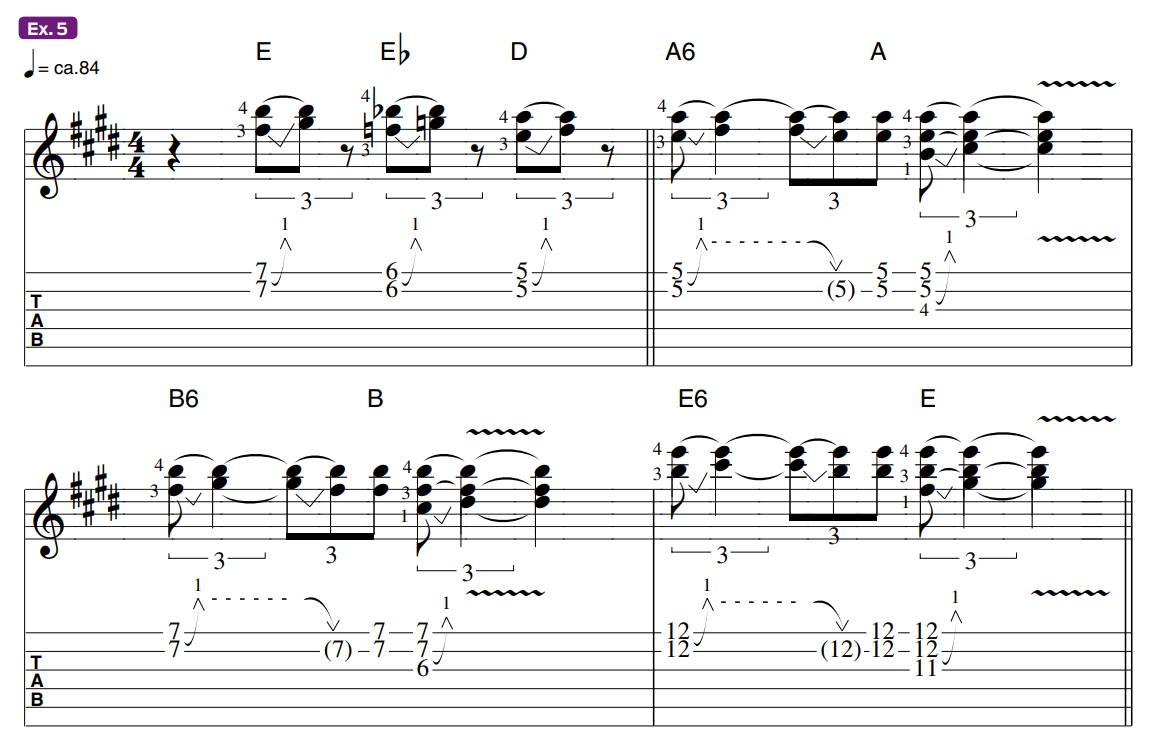
Ex. 5 recasts Ex. 4’s chromatic intro pickup as a trio of descending oblique bends derived from Ex. 1d.
The IV-, V- and I-chord licks in bars 2, 3 and 4 use the same rhythmic phrasing as the first two beats in bar 1 of Ex. 4, applied to oblique bends derived from the bottom two notes of Ex. 2b, transferred to the top two strings.
The second half of each bar features the obliquely bent E triad from Ex. 2b applied to the A, B and E chords.
Examples 5 and 4 can be combined in succession (in that order) to craft an eight-bar solo.
Build a Chorus
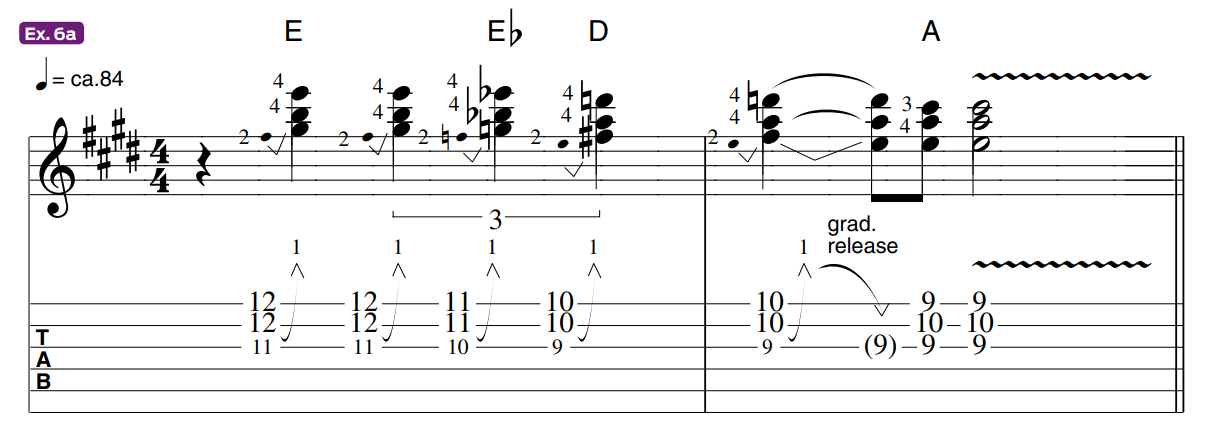
The pickup in bar 1 of Ex. 6a mimics the song’s chorus vocal phrasing by converting the moves from Ex. 4’s pickup to a quarter note on beat two, followed by a dragged quarter-note triplet, all performed using grace-note bends.
The obliquely bent D triad repeats in the next measure (bar 1 of the eight-bar chorus) and is then lazily released to sound a brief Asus4 before resolving to a pair of A triads.
You can construct an entire chorus using previous examples as follows: Play Ex. 6a; play bars 3 and 4 from Ex. 5; repeat Ex. 6a; and play bar 2 of Ex. 6a transposed up a whole step (two frets lower).
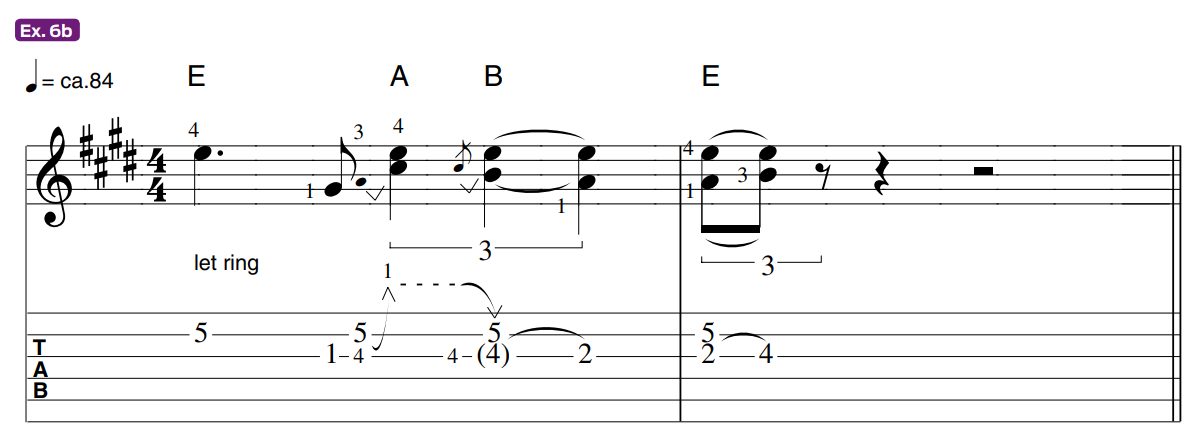
Cap it off by dropping down to second position and playing the stretchy two-bar lick in Ex. 6b, which features yet another variation of the held oblique bend, picked grace-note release and single-note pull-off found in several previous examples.
Build a Solo
Ex. 7 paraphrases the first half of Rhodes’ solo.
The pickup bar transposes the double-stopped bend from Ex. 1b up a fifth and seven frets, then drops it two consecutive half steps and frets.
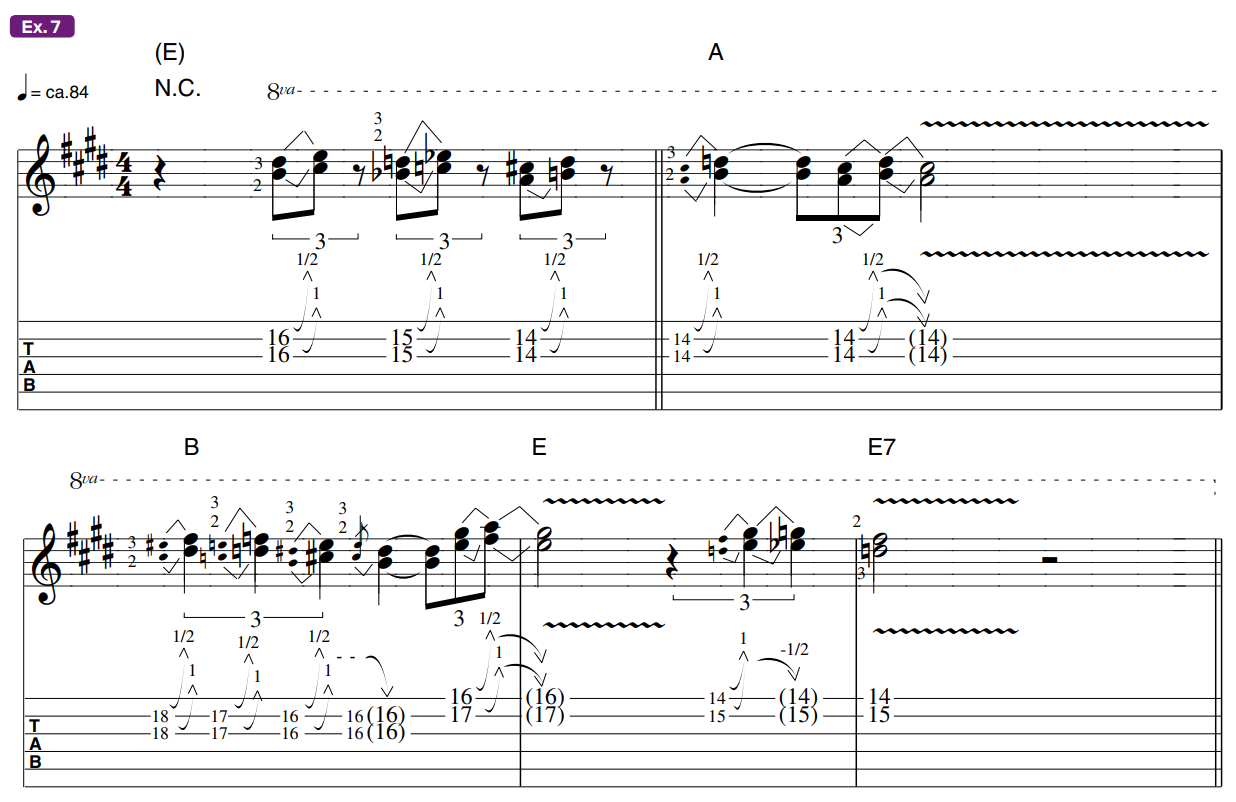
Bar 2 (actually bar 1 of the eight-bar solo) is identical to bar 2 of Ex. 3b.
The chromatic double bends in bar 3 begin a whole step higher than the pickup and target another picked grace-note release on beat three, before anticipating the E chord in bar 4 with the same double bend (plus release) applied to a partial E chord on the top two strings (G# over E).
Move the same shape down two frets, bend both notes up a whole step (ouch!) and partially release them by a half step before targeting the bend’s point of origin on the downbeat of bar 5.
Fill the rest of that measure and the remaining four bars of the form with any combination of Ex. 3b and Ex. 4, and you’re good to go.
Bring It on Home
The short ending lick shown in Ex. 8a requires some tricky sleight of hand that is well worth the effort.

Slide into the opening G# note, let it ring beneath the E added on beat two, bend the G# up a half step to A and hold it while adding the D# note on beat four.
Then, simultaneously release the bent A back to G# while sliding D# up to E.
Even more painful is the version that’s shown in Ex. 8b, which starts the same as Ex. 8a, but ends with a simultaneous bend from D# to E and release from A to G#.
Yow! That’s some contrary motion!
So there you have it. Apply these examples to your own cover version of “Don’t Bogart Me” and you’re sure to have a real crowd pleaser in your set!
(Lyric suggestion: Try substituting joint for vape.)
Get The Pick Newsletter
All the latest guitar news, interviews, lessons, reviews, deals and more, direct to your inbox!
“Write for five minutes a day. I mean, who can’t manage that?” Mike Stern's top five guitar tips include one simple fix to help you develop your personal guitar style
"It’s like you’re making a statement. And you never know where it’ll lead." Pete Thorn shares the tip that convinced Joe Satriani he was the right guitarist for the SatchVai Band










